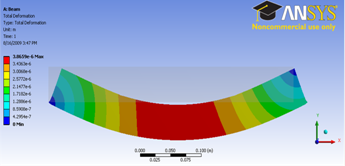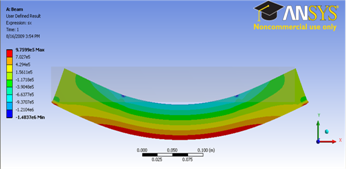| Include Page | ||||
|---|---|---|---|---|
|
Step 6: Results
Total Deformation
Let first look at Total Deformation. Under Solution (A6), click on Total Deformation. The Total Deformation plot is then shown in the Graphics window.
| newwindow | ||||
|---|---|---|---|---|
| ||||
https://confluence.cornell.edu/download/attachments/112040800/Deformation.png |
Note: To show the original undeformed beam, go to third menu click and click on
Notice the deformation is exaggerated, revealing that deformation is caused by bending.
You can also animate the deformation by clicking play button right under Graphics window.
Bending Stress
Now let's look at the stress on the beam. Left clicking on User Defined Result under Solution (A6). In the Graphics window show the crank stress contour.
| newwindow | ||||
|---|---|---|---|---|
| ||||
https://confluence.cornell.edu/download/attachments/112040800/Bending%20Stress.png |
We expect a pure bending stress in the central region between the two applied forces. The stress is tensile on the bottom surface and compressive on the top surface as expected. Elementary beam theory predicts the bending stress as σxx =My/I. Here
M = 4000*0.1 = 400 N m
I =bh3/12 =(1)*(0.05)3/12 = 1.04e-5 m4 (assuming unit thickness in the z direction)
For this geometry, we expect the neutral axis to be at y =h/2 =0.025 m. So the max value of σxx= M*(h/2)/I = 9.6e5 Pa. This is reasonably close to both the maximum value of tensile and compressive stresses from the computational solution. We have a relatively stubby beam; the agreement with beam theory should improve as the length/height ratio of the beam is increased. Also, the FEA solution perhaps can be made more accurate by refining the mesh. This is left as an exercise to the reader.
Note: We see stress concentration appears around the region of the point force and point displacement. A force and displacement applied to a vertex is not realistic and loads to singular stresses (that is , stresses that approach infinity near the loaded vertex). We should disregard stress values in the vicinity of the loaded points.
Go to Step 7: Verification & Validation
 Sign-up for free online course on ANSYS simulations!
Sign-up for free online course on ANSYS simulations!

